Corcovado National Park, Costa Rica
Anna's entry -
Before heading out to Corcovado National Park, we made a stop in Golfito, and hiked a rarely visited Refugio Nacional de Vida Silvestre Golfito - a home to abundant species of plants and animals. We did our hike early in a.m., it was all up the hill, but it definitely was worth it. We saw LOTS of white-faced capuchin monkeys - at one time we probably saw about 20 of them climbing the tress, as well as a family of beautiful toucans. Unfortunately, even in this protected park, we observed some housing development - which means the nature here in next 10-20 years most likely will be gone.... Really glad we were able to experience it while it exists, but really sad to see what we are, humans, doing to the environment around us...
After Golfito we took a ferry to Puerto Jimenez - not a very friendly town to outsiders, but it is a gateway to the Parque Nacional Corcovado - a highlight of out trip. This unspoilt national park is the last original great react of moist tropical forest of the Pacific Central America. Covering the southwestern corner of the Peninsula de Osa, it is home to Costa Rica's largest population of scarlet macaws as well as great animal and plant species, including jaguars, pumas, coatis, toucans, and snakes. We were able to rent a tent, and spent two days and one night in the Corcovado National Park. It was a great experience! We spent two days hiking, saw a great variety of animals, and set up our tent right on the ocean shore at the park entrance, so we could hear the waves and palm tress at night. During our two days of hiking we saw numerous scarlet macaws - gorgeous huge parrot birds, which were lucky enough to survive all that craziness of being pouched, and are currently protected in the park. We also saw lots of monkeys - white-faced capuchins, and spider monkeys, as well as two large families of raccoon-like animals *I am going to look up the official name of it soon* - they were not afraid of us at all, and were digging big holes in the ground, and pulling out big land crabs right in front if us. The highlight of our hike was bumping into a puma, who after a hunt was carrying a captured animal victim in her mouth. Besides mammals, we saw lots of goat spiders - they make very strong web threads, used for bullet proof materials. We also left with a little present from the park - apparently there are tons of small tics living there, and about 10 of them attached themselves to me, with other 7 of them to Rob. It wasn't very pleasant to pull them out, but luckily they do not carry any disease. Not a big price to pay after all that great hiking experience!

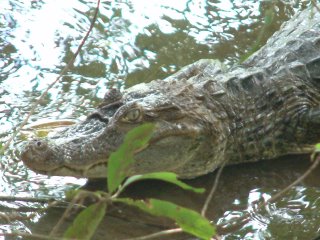






David & Caldera, Panama
Anna´s entry:
We stayed in David city for a few nights, and made several trips to other towns in the mountains. One of them was Caldera - famous for natural hot springs. Hot springs are called Los Pozos de Caldera, and they are known for their health-giving properties. Hot springs look like small pools in the ground surrounded by rocks, the water is coming virtually out of the ground, and the water temperature is pretty hot. After sitting in the springs for a few minutes, we would run down to the mountain river, and get cooled off in the stream water. It was a great refreshing experience. Also, we met a local family there - and they invited us to visit. Another town we visited in the mountain was Boquete - it is a very pretty place with mist-covered mountains, pristine forests, and cool refreshing streams, however, currently it is over-taken by westerners, who bought up the land and built up huge villas. I guess it reminds them of Switzerland... We hope that the pristine nature will be able to survive after all of this villa development nonsense, unfortunately, we have seen so much of the pristine beauty already gone...

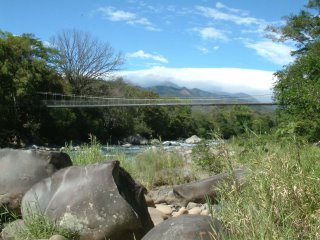

El Valle, Panama
Anna´s entry:
El Valle pleasantly surprised both of us. First of all, we finally met genuinely friendly people, who were not afraid to show an interest in us - outsiders. They were not trying to sell us anything, they just sincerely wanted us to feel welcomed. What a refreshing change! I felt as if we were in Tibet of Central America... The town itself is very picturesque - it is located up in the mountains, abouts 4 hours away from Panama City, and the actual town was built right in the middle of the extinct volcano crater. Nature and landscape is absolutely gorgeous there. Rob and I hiked to waterfalls, and just around the hills and some pre-Colombian rocks. While hiking up in the hills, we run into a few locals living in the mountains. The hike was steep and strenuous, and it took us about an hour to reach the top - apparently, locals use the same hiking trail everyday, and it takes them only 25 minutes. When I asked one of the locals if he walks the mountain trail every day, he said with a smile ´´No - I actually run every day´´.
We received an excellent impression about El Valle, and wish we could spend more time there!



Panama City, Panama Canal, Isla Taboga
Anna´s entry
We took a boat from Bocas del Toro island to Almirante (mainland), and then a bus from Almirante to David city, abnd then a night bus from David to Panama City. The bus ride from Almirante to David was an absolutely the most beautiful ride I´ve EVER taken. The scenery was breathtaking! The nature we´ve seen is what one could imagine be a National Geographic cover story, or nature documentary. We did not expect it to be so stunning. Words can not give justice to describe it, so I will only attempt to give some details. In a distance we could see dark blue color of the Caribbean sea and islands, then we would go up into the highlands with clouds sleeping among the mountains and rolling skills, we start with a rain forest at the bottom of the hills, and it would transition to ever green forest at the top of the summit; rivers and lakes could be seen in the former volcanic craters, with a sunset on the background of the mountain cones and a dark blue forest in front of it. I think the pictures will forever stay in my mind...
We reached Panama City at 5 a.m., and were very surprised to see such a modern city with numerous skyscrapers and very modern infrastructure - this is yet another contrast of the gap between the rich and the poor part of Central America. We stayed in El Cangrejo district which is more of a financial and nightlife part of town. After traveling for two months in very poor countries, staying there was our retreat. Our main reason for coming there was for Rob to get some medical advice on his persistent condition, and of course to explore the area of Panama Canal and islands in the area.
There are actually three Panama Cities - the modern one - Panama City, the old one - Casco Viejo, and the original one - Panam Viejo with ruins dating back to the 16th century. The modern Panama City is VERY cosmopolitan, and was surprisingly enjoyable compared to other capitals of Central America we´ve visited. This is probably the first big city in C.A. we would consider living in. It is a kind of New York-Miami mix if I could compare it that way. Casco Viejo on the other hand - the old distrcit- was very interesting. The contrast of expensive mansions and shacks without windows was surreal. We walked by the President´s home - modern palace - which was right in the neighborhood with gritty falling apart ghetto homes. The contrast was something else! Panama Viejo (the old original Panama City) had interesting ruins and history. Like many other Panamanian cities it was attacked and destroyed by the notorious captain Henry Morgan - the pirate who terrified the areas of the Pacific in the 17th century.
We also visited Panama Canal and watched the ships go through Miraflores locks. The Canal history of design is very interesting, and incorporates French and American involvement, with thousands lives lost while building it. In 1999 the US officially passed the ownership rights to Panama, and currently it is a very profitable business for Panamanians. The largest passenger ships passing through the Canal are charged around $150,000 USD per transit. The lowest fee ever assessed was $0.36 paid by Richard Halliburton, who swam through the Canal in 1928.
Besides the Canal, Rob and I also took a ferry to the Isla Taboga - the famous pirate island of the 16th-17th centuries. The infamous Henry Morgan (mentioned above) used the island as a base to attack ships and towns. Nowadays it is a peaceful island with gorgeous scenery. Unfortunately we had only a few hours for hiking and exploring it, which was not enough, but the time spent on the island recorded beautiful seascapes and historical points.
Panama City is our turn-around point. After it, we are heading back north, and exploring more of Costa Rica, Nicaragua, Guatemala, Mexico, as well as also hoping to visit our new destination - El Salvador.



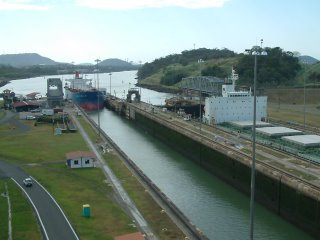
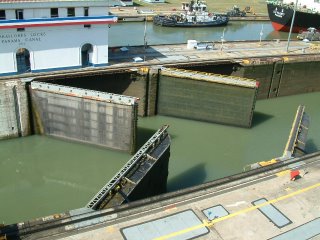
Bocas del Toro, Panama
Anna´s entry -
We immediately could tell we were no loner in Costa Rica! As soon as we walked across the border, we got immediately hassled by taxi drivers and young kids. They were more polite and less obnoxious though compared to what we experienced in Guatemala and Nicaragua. We took a boat to the island of the Archipielago de Bocas del Toro. Unfortunately, Rob got really sick again. Poor thing, he spent the entire night throwing up, and his limbs got covered in awful red blisters. This is the fourth time he showed that reaction, so we are wondering if there is something in the rain forest that he is reacting to. Anyway, Rob spent three days in the room, and I myself had an adventure that somewhat shook me up... But before I explain, I must share our experience with a Doctor on the island. We went to the hospital to hopefully get some info on what´s happening with Rob. The doctor turned out to be fluent in Russian, in addition, he graduated years ago from a medical school in my home town - Petersburg, Russia - and is very fond of it. He could not help Rob much (he instructed us to consult a specialist in Panama City asap, which we did today), but we spent an hour chatting in Russian, and the doctor invited us to stay with him and his family the next time we are in Panama.
Anyway, going back to my adventure... One day I decided to join a group for a tour of the islands. The first part of the day was awesome - we saw dolphins, did some great snorkeling, saw a stunning coral, etc. For the 2nd half of the day they took us to the gorgeous beach...and this was where my adventure began and luckily ended. A couple from Germany decided to go for a swim, and invited me to go with them. The waves were somewhat high, so we decided to stay in a shallow water. Well, we jumped over the 1st wave, and the 2nd wave, and... all of a sudden, we could not feel the sand under our feet, and all three of us were getting away from the shore. I am suspecting it was a riptide. We tried to swim back to the shore, but the waves were too high, and we got pushed by them under the water surface. This was the first time I got scared for my life, also I felt stupid for going against my judgement - not to swim in the waves, even though someone else was doing it. Luckily, I am a trained swimmer, and was able to stay over the water as much as I could. And, not being able to swim against the waves, I tried to ride them (kinda like a surfer without a surf board, just swim-surf). It is possible that that worked, or maybe the riptide stopped, and myself and the other girl got back to the shore. Her husband however was another story... He could not overcome the waves, and stayed behind struggling, his wife was in panic too - he seemed to be drowning bit by bit. As soon as we got back to the shore, we run for help. A local guy working at a restaurant dropped everything, and rushed into the water, as well as another young guy (a tour guide, who coincidentally was on a shore with another group) swam back to the drowning guy and helped him back to the shore.
That day I found out that two other people were taken out by another wave (but luckily they also got out OK); as well as I learnt how much respect we need to pay to the ocean and waves. I can not imagine what the professional surfers must go through, and I´m sure glad I am not one of them. I was definitely shook up after that mishap, and even though I was able to stay calm, not panic, and get out of the waves OK, it was definitely a scary experience. I am very grateful that all is well, and the lesson about the waves has been very much noted and will be remembered. Bocas del Toro turned out to be a very different type of experience after all.
Internet links with Bocas del Toro photos:
http://www.bocasdeltoro.com/bocas6.jpghttp://www.scubapanama.com/marcas/deepsee/Clipart/bocas5.jpghttp://twoday.net/static/sierralog/images/RedFrogBeach.jpghttp://wsb.brinkster.com/safaripanama/Images/reef%20bocas.jpghttp://www.panamajetboatexplorer.com/sitebuilder/images/Dolph_4A-300x185.jpg
Puerto Viejo, Costa Rica - with PHOTOS
Anna´s entry:
Located on the Caribbean side, it is a prime destination to
the country biggest and most powerful waves. However, the reason for us going there was Gandoca-Manzanillo wildlife refuge. We took a 5.5 km coastal trail through the preserve and were really impressed with it. Though the trail in parts was muddy and wet (even now, a week later we are still trying to clean our hiking boots), the nature, coastal scenery, and animals were well worh it. I can not wait to post the photos we took! We spent the entire day in the forest and the coast, and saw the following species - spider and howler monkeys, tayra (related to black panther), goat spiders, red frogs (those are so cute, about an inch big, and llok like small strawberries), wild parrots, lots of crabs, iridescent butterflies, tropical fish, etc.
Another thing that made it very pleasant for me in Puerto Viejo was the place we stayed at. Well, actually, we had to change our accommodations at first... The first hotel we stayed at was full of surfers high on drugs - they virtually we walking around with their pipes ready to lit up. Anyway, we moved to a different place, and what a treat it was! Run by a German couple, and being inexpensive, we stayed in a house in the middle of a lush tropical garden. Needing a little rest after all our early a.m. hikes, we spent one of the afternoons in a hammock, it was so nice with all these tropical blossoms around us. We also had an excellent kitchen set up for us to use, and we cooked a home made meal. I must admit that so far I have observed that Germans run the best kept accommodations, so from now on I am looking for places to stay with a German name on them.
Also, the owners were experts in Costa Rican living, and are into natural medicine made from locally grown plants and fruits. They let us taste one made from a local tropical fruit called cheese fruit. Supposedly, it treats all illnesses if you drink it regularly on the empty stomach. It was a fun experience, but the remedy tasted awful - bitter-sower, and stinks like like a spoilt cheese. We also learnt from them what it was like to live away from their home country for years - and apparently they have no desire to return back to Germany - they feel that the beauty and tranquility of Costa Rica can not be repeated in their home land. After Purto Viejo de Limon, our next stop would be in Panama.


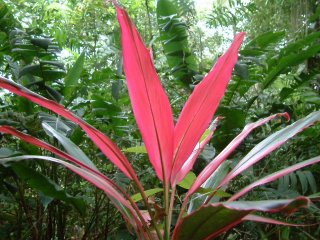





Tortuguero, Costa Rica - with PHOTOS
Anna's entry:
Tortuguero is located in northeastern Costa Rica, on a tiny slip of land between the Tortuguero canal and the Caribbean. Parque Nacional Tortuguero is home to some of the greatest biodiversity in the country, and is referred to as "mini-Amazon". Caimans and crocodiles can be seen lounging on river banks, while fresh water turtles bask on logs.
To get there was an adventure in itself. We got their in a motorized boat - navigating there for two hours along the river in the rain forest. The village of Tortuguero is located right at the entrance to the rain forest. We spent two days exploring the National preserve while hiking, and took a canoe tour with a local guide exploring the rain forest friom the river shores. It was REALLY COOL! We saw three ty pes of monkeys - spider monkey, white-faced capuchin, howler monkeys; sloth; iguanas; Basilisk lizard (aka Jesus Christ lizard - called so because of its ability to run on the surface of the water); alligator lizards; boa constrictor; young caiman; and lots of birds - blue herons, anhingas, small toucans, and tiger herons. The latter one makes a scary loud sound when approached, and it does sound similar to the tiger!
Also, the last night before our departure we got invited be another traveling couple from Italy to their home made dinner, and we had a great time sharing our stories.
We returned back from Tortuguero by taking a boat again through the great rain forrest, and while crossing the river, Rob saw a caiman (small crocodile). We are really glad we made a trip there, Tortuguero national preserve was a truly enjoyable and rewarding experience!



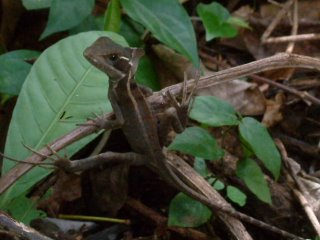



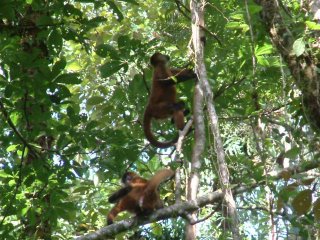

My View - SJdS (Nic) to Tamarindo (Costa Rica) [Rob´s entry (#5)]
Standard disclaimer: Anna does an excellent job covering the positive aspects of our trip, and I try to fill the ‘other side’.
San Juan del
Sur (Nic)
Not too much to say about SJdS. Lots of Gringos buying up property. As we are looking for a possible place to live someday, we try to place ourselves in towns like this. While picturesque, we think we'd go crazy in these places. They seem so small, and we tend to be more urban. That said, we spent a great morning with a picnic breakfast at the beach consisting of yogurt and dirt-cheap dead-ripe tropical fruit. One huge treat for us are the cheap bananas, papaya, pineapple, oranges, etc. We frequently have fruit for breakfast, on the bus, or for a quick snack. The harbor around SJdS was studded with mansions of affluent Nicaraguans and gringos. We found some great street food from vendor's BBQ's from what seems to be grills made from automobile rims. We have observed these grills all over CA.
Ometepe (Nic)
Anna covered pretty much all the high and low points of the location. A couple of things she missed was that our first night's experience was pretty miserable as we stayed across the street from a roaring disco. It's construction resulted in the sound basically being in the street rather than contained by the 'walls'. This went on late into the night/morning, as was followed by the patrons carrying on the party after closure. We quickly changed location after learning that was a nightly occurrence. Another thing we observed was that while many of the rural homes viewed were unimaginably poor by western standards (corrugated tin and board construction, like a dilapidated farm shed for example), many of the people (particularly women) were very well dressed (far better than us for sure). Many of the women were well groomed and wearing dresses, etc.It was a contrast that we both noticed, and were at a loss to explain. Anna thought it was an attempt not to look poor, and I wondered if the women might get treated more respectfully if the appearance was more upscale.
A note on poverty. As early mentioned, I've given a lot of thought about the 'poverty' I've seen. I may try to write a separate entry regarding some of my views at some point.
Liberia (Costa Rica)
This entry is more about the weeks of travel before CR, but the contrast and discovery between other countries and CR hit us on our first stop- Liberia.
Again, Anna pretty well summarized our initial impression of Costa Rica. It was the sharp contrast that opened our eyes to the experiences we had in the northern countries. We has a employee at a bank quietly suggest another bank for us to get a better deal exchanging money, and a store worker 'take' heavy coins from us in exchange for paper money so we'd have less weight to carry. We received coupons for a free drink, smiles and helpfulness in stores, etc. It was then that we realized how beaten down we had become. It puzzled me for a long time why this contrast was so overwhelming. Anna's theory sounds about the best that our time spent in these countries has resulted in us absorbing of 'everything' than one normally would. For example, if one were blowing through for a couple of weeks on a vacation, you wouldn't try to find the best value on where to stay, eat, etc. Of course, we are always looking for the best value (typically at the lower price end), even in the poorest of places. Even though the taxis are cheap, we still travel by 'chicken bus'. We are closely examining what it is like to live in these places, medical care, how the people are, what we would do with our time, etc. As Anna grew up in a poorer country, she recognizes many things (mostly bad) going on and calls attention to them. It stirs past unpleasant feelings in her. Without her insight , I'd likely not even notice certain things (like how we are treated sometimes), or would blow it off. It is harder for her sometimes, adding to the stress. It is difficult at times to be treated poorly or disrespectfully, to stumble through on limited Spanish ability, in areas where life is difficult (for the residents), constantly being hustled to buy something, and dealing with many people who have developed a hardened harshness to them (no doubt as a way of dealing with their environment). I think we absorbed more of all this, making the whole experience more challenging, and at times, certainly less enjoyable. At the same time, I also think we have perhaps seen a more accurate portrayal (as an outsider) of the places visited. Our first day in CR brought all this to our attention in a confusing way that will likely be in our minds for a long time to come. While absolutely great travel experiences, it does help resolve some questions of where to (or not) live someday.
Tamirindo (CR)
One thing Anna failed to mention was that we lost two shoes (one of hers and one of mine) during the swim back to shore. That was a major bummer, along with getting a couple small cuts in my wetsuit. The other travelers we met there were largely uninteresting (with a couple of exceptions), spoiled, complaining, consumed with partying, hooking up, and full of attitude because they were surfers (many other travelers we met had much more character, but unfortunately, I had hoped for more on this trip). The nature and waves helped make up for all that however, and we found the stopover enjoyable overall.
Current location: Isla Bocas del Toro, Panama. Next stop- Panama City (another doctor visit, rashes and vomiting still persistent).
My View - Tegucigalpa (Hond) to Granada (Nic) [Rob´s entry (#4)]
Standard disclaimer: Anna does an excellent job covering the positive aspects of our trip, and I try to fill the ‘other side’.
Tegucigalpa was an unremarkable place, and while we were there, we
continually encountered the same heavy techno Rapp beat placed over and
over (Reggaeton Gasolina). ´Goosi´ (as I termed it) was the cleaner of the twin cities (capitol of Honduras); Comayaguela (Chumunga, as I called it) was the other. For some reason, the latter held some fascination for me. It was unbelievably
chaotic, gritty, dirty, decrepit, and it seemed that anything and everything
was for sale. The whole decaying city was a giant market place.
Passing through into Nicaragua was fairly uneventful; however cashing
travelers checks proved to be very difficult (even at banks, impossible
other places). Anna became ill and we hung out in Leon for a few days. The
ride there was difficult for her as the roads were very bumpy and
exacerbated her condition. I determined that (at least this) Nicaraguan bus drivers honk for the following reasons:
1. I'm coming, get out of my way.
2. I've passed you.
3. Hello!
4. Get out of my way.
5. Goodbye!
6. Any other reason.
7. No reason.
Also of note were some of the road kills observed. I’ve seen a number of different animals on the road, but only in Nic did I see horses. I wondered if losing your horse was equivalent to wrecking the family car, as we often see them pulling carts, etc.
One of the characters we came to know in Granada was a wretched woman who
sits on the cathedral steps and bellows to all “I am hungry, one dollar
please”. Not to be crass or insensitive, we both thought that $1 was a bit
excessive as we often eat for about $0.60 each for dinner. Some days ago, I
bought something disgustingly sweet thing (told it was chocolate, btw-
chocolate isn’t popular here and can’t find it—huge cravings…). One day,
remembering her pleas, I took those sweets with me in case wed meet her.
Sure enough, we did and she enthustically accepted my offering, showing me a
generous toothless smile. I will say that it did bring a good feeling over
me, and did remind me of the conditions of others. On a serious note, Anna
and I have had a lot of introspective philosophical analysis of the poverty
we witness, and what our roles and responsibilities are regarding it. Perhaps more to come on that subject later.
San Jose, Costa Rica - with PHOTOS

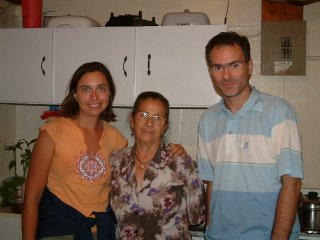
Anna's entry:
We stayed with a wonderful local family. The mother - Carmen - was very nice to us. She made sure we had enough to eat, gave us the keys to her house, introduced us to her friends and the neighborhood, and we chatted with lots of her neighbors. She seemed to have been very proud of hosting us, and felt sad when it was time for us to leave. She told us to make sure to come back and stay with her and her friends on our way back. Generally, Costa Ricans seem to be very nice, friendly, and helpful. They also seem to look a lot happier than locals living in Nicaragua or Guatemala. Both Rob and I noticed how much peaceful both of us feel after our arrival to Costa Rica. So far, we are really enjoying the country.
Tamarindo, Costa Rica - with PHOTOS
Anna´s entry:
Tamarindo is sometimes called by the local "Tamagringo" because of the ex-pats living here. Nevertheless, it is located on the stunning coastline of the Pacific. Waves can get pretty high here, and create a beautiful coastal landscape. About 600 meters (1,800 feet) from the shore lies a small island El Capitan; and Rob and I decided to swim there in hopes of a good snorkeling. Well, it wasn't' as easy as we thought. When we reached the island wind and waves picked up, and it was very hard to get out of the water to the island shore. Rob has a long wet suit, however, mine did not cover arms and legs, and I got lots of scratches from the rocks by bouncing in the water between the rocks trying to get up. We did manage it from the other island side, and enjoyed the island, however snorkeling was poor there. We swam back to the mainland without issues, but it did bring up a couple of worrying thoughts in my mind when seeing a couple of bigger waves coming up. It was an interesting experience, but I recommend to use a kayak for someone who is interested in going to the island - I think it would be a little safer than swimming. Our next day in Tamarindo we took it easy, and spent our free time on the shore admiring the beautiful waves from the distance.


Liberia, Costa Rica
Anna's entry:
Rob and I could not believe what we saw... After weeks of traveling in poor Nicaragua, Honduras, and Guatemala, we felt we got back to the US when we arrived to Costa Rica. Nobody yelled at us to hurry to get on a bus, nobody
short-changed us at the bank or the store, and people actually looked and talked happy... We went to a grocery store in Liberia, and our jaws dropped - we have not seen that much food in a while. After weeks of eating at dirty stalls, it was actually a kind of nice to see more variety, AND the
chocolate was actually available! What a treat it was! We definitely did not expect such a contrast in standard of living with other neighboring countries.
Isla de Ometepe, Nicaragua - with PHOTOS
Anna's entry: That was a very interesting experience! The island is formed by two large volcanoes - Volcan Concepcion (1,600 meters above the lake Nicaragua), and Volacan Madera (1,394 meters). Lava flowing from the two volcanoes created an isthmus between them, and united both in a single island. Getting to he island was an experience in itself. First off, the day we arrived to the boat dock, it was very windy, and the waves were high, so they canceled all boat departures, and we had to turn back. Secondly, we were told later on, one of the boats sunk a few days prior while disembarking. Thirdly, the day we were finally able to get on the boat, it was still very windy and wavy, but boats were sailing that day anyway. Let me put it this way - I do NOT get sea sick easily, but that day I came very close to throwing up. The boat was like a box of matches thrown by the waves, the guy inside of the boat kept pumping the water out (though some crazy device), the passengers were required to put life vests after boarding the vessel, the engine was loud, the kid to us kept creaming, etc. - so you get the picture. I think it would be acceptable to borrow the term "chicken bus", and call the boat "chicken ferry". The island itself was gorgeous. Rob and I took a nice hike in the forest from where we could see the volcanoes, and other islands of the Lago de Nicaragua. And during another hike, we saw lots of howler monkeys in the trees. One of them had a cute baby on its back and seemed like it was teaching the youngster to climb the brunches. Also, on the way back to town, our "chicken bus" hit a big rock on the already challenging road, and it broke an engine mount, which slammed the engine into the radiator. So, there we were, sitting on the road, in the middle of nowhere. There were other buses though, and we took a detour with other locals. During this detour we learnt that pigs are a king of cool in the animal world of Nicaragua, and they run the show around here. We observed a little female piglet harassing a big male dog, and generally pigs control the roads here. By the way, that little piglet was running in the park in the center of town, and we had no clue where it came from, but locals seem to be used to this. Anyway, I gained a tender appreciation and respect
towards pigs and piglets here.
On a sadder note, we also encountered a discrimination on the island. We went to a local restaurant, and would not be served for being the "gringos". That was the first time it was obvious, and we stood up and left. I did tell the lady what I thought about her. It brought up in my mind memories about other minority groups, and what they must feel when they deal with discrimination on every day level. It definitely reminded me how ignorant we can be as humans, by judging a person on a basis of color, race, or nationality. Over all, however, Nicaraguans were friendly and we met a lot of very kind individuals. |
|





San Jose del Sur, Nicaragua - with PHOTOS
Anna's entry:
Nice small town on the Pacific coast, however, is getting to be over-taken by ex-pats, who are buying up land on the coast. We spent a couple of quite days there - enjoying walks on the beach, watching the ocean and stars. By the way, who said that cats are afraid of the water? During our evening walk on the beach, we saw two cats playing and running right on the beach. I couldn't tell if they were right in the water, but I definitely observed the waves splashing at their paws. It was very entertaining to watch.

















































